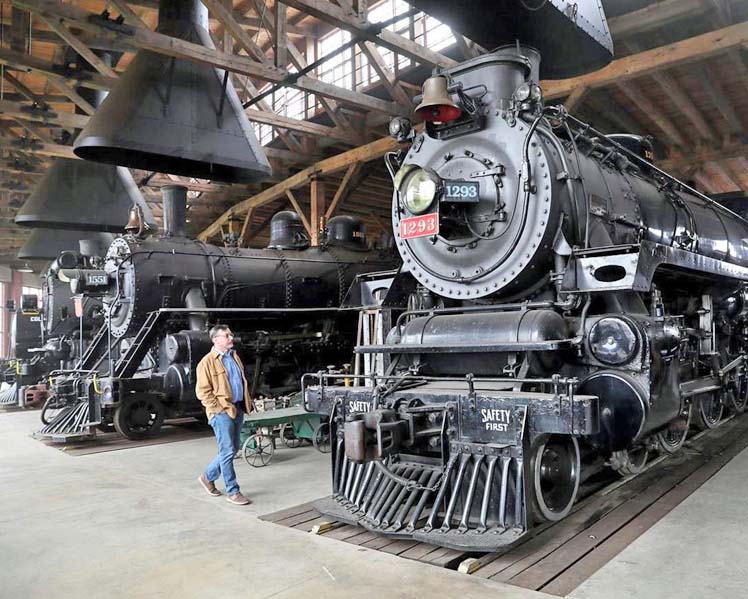
Sugarcreek Ohio USA - Jerry Jacobson was a young boy in Cuyahoga Falls, living near the Baltimore & Ohio Railroad, when he first fell
in love with steam trains.
Fast forward more than 50 years, and dozens of objects of Jacobson's affection are on display in a new tourist attraction, the Age of Steam Roundhouse, in
Ohio's Amish country.
Jacobson, who passed away in 2017 at age 74, eventually acquired nearly two dozen steam locomotives, many of which have been painstakingly
restored.
They're housed in an immense, stunning, roundhouse, with stalls for 18 locomotives and a working turntable, open to the public for regularly scheduled tours
for the first time this month.
"It was kind of a playground for him," said Noel Poirier, who was hired last year as the facility's first executive director.
"But the intention was always to open it up and share it with everybody."
Jacobson, a nurse anesthetist by profession and an Army veteran, bought 90 miles of little-used railroad through east-central Ohio in 1988.
He also purchased a steam locomotive and several passenger cars, and operated a steam-powered tourist train from his hometown of Sugarcreek for 15
years.
That small operation soon became considerably larger.
Jacobson eventually owned 10 railroads operating across 455 miles of track in Ohio and Pennsylvania, carrying passengers and freight throughout the
region.
He sold the operation in 2008 for more than US$200 million, according to news reports at the time.
And with the proceeds, he built the Age of Steam Roundhouse, the first fully operational roundhouse built in the United States since 1951, according to
Poirier.
On display inside is what is believed to be the largest private collection of steam locomotives in the world.
"When I tell people I designed a roundhouse, they think I mean I designed a round house," said Columbus architect Ted Goodman, who designed the
building.
Goodman, a rail fan himself, pored over old photos and drawings to come up with the design, which aims to replicate a pre-World War I roundhouse, before steel
construction became the norm.
It's a massive, timber-frame building, 48,000 square feet, with 40 foot high ceilings, Belden Brick walls, and heavy oak doors.
Banks of windows flood the space with natural light.
In addition to the 22 steam locomotives, the facility is also home to a dozen diesel locomotives, passenger cars, freight cars, and miscellaneous train
equipment.
Although the collection includes vehicles that span nearly a century of railroad history, the museum plans to focus on what Poirier calls the "golden age
of steam," roughly the 1920s to the 1940s, before diesel engines, air travel, and the interstate highway system relegated steam trains to the rear view
mirror.
"It's a living history site more than anything else," said Poirier.
"You're transported in time."
Among the vehicles on display:
- The 1942 Grand Trunk Western locomotive used to pull President Harry Truman's campaign train in 1948. Built by American Locomotive Company's Schenectady
Works, the locomotive was purchased by Jacobson in 1993. Its last run was in 2005;
- A 1905 locomotive built by American Locomotive Company's Pittsburg (no "h") Works, which was still in use in the early 1960s on the Morehead
& North Fork Railway in eastern Kentucky. Jacobson, a paratrooper in the U.S. Army's 82nd Airborne Division, would occasionally take the bus from Fort
Bragg, North Carolina, to see the locomotive in action. He bought it in 2011, restored it, and it's now one of two steam locomotives certified by the
Federal Railroad Administration to run;
- A couple of movie stars, including a 1915-era locomotive by Baldwin Locomotive Works featured in the 1972 film,
Emperor of the North Pole and a 1948 Canadian Pacific
locomotive used in the 1979 movie Terror Train;
- A rare compressed air locomotive, built by Pittsburgh's H.K Porter Company specifically for work places that couldn't handle the heat and sparks associated with burning coal. Built in 1915 for use on a Cuban sugar plantation, this locomotive made its way to Sugarcreek four years ago.
 In addition to the roundhouse, visitors will tour the maintenance area, where vehicles are brought back to life by a
dozen or so workers skilled in restoration.
In addition to the roundhouse, visitors will tour the maintenance area, where vehicles are brought back to life by a
dozen or so workers skilled in restoration.
In the "garage" earlier this month, a relatively diminutive 1943 Baldwin Locomotive Works engine, commissioned by the U.S. Army and designed to be
shipped to Europe.
This one stayed stateside, and is being restored for the museum's Steam to Victory event in early July, commemorating the 75th anniversary of
D-Day.
In recent years, the roundhouse has been open to the public on occasion, for special events and private tours, usually for groups of railroad fans and history
buffs.
The entire operation is supported by the non-profit Jerry and Laura Jacobson Foundation.
Members of the family live nearby and sometimes give tours themselves.
The challenge facing Poirier, and his staff, is to broaden the appeal of the attraction beyond rail enthusiasts.
Poirier said he hopes to draw a fraction of the millions of tourists who travel through Holmes and Tuscarawas counties each year.
In particular, he is looking forward to welcoming young people to the facility, hoping to capitalize on kids' early love of trains.
(Think "Thomas the Tank Engine", "The Polar Express," "Harry Potter" and others, he said.)
Currently, there are no plans to offer train rides at the facility, though Poirier said they may be added at some point.
The facility maintains 3 miles of track on the 30 acre property.
"Someday I think we'd like to get out there and run them again," he said.
Until then, it's enough to walk among these metal giants and hear their stories.
Susan Glaser.
provisions in Section 29 of the Canadian
Copyright Modernization Act.

